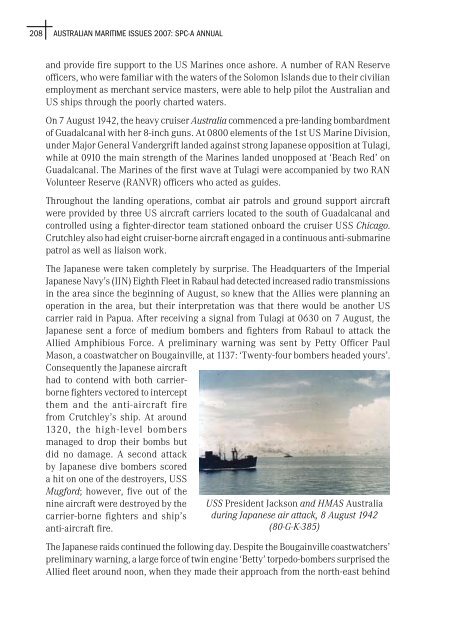Australian Maritime Issues 2007 - Royal Australian Navy
Australian Maritime Issues 2007 - Royal Australian Navy
Australian Maritime Issues 2007 - Royal Australian Navy
Create successful ePaper yourself
Turn your PDF publications into a flip-book with our unique Google optimized e-Paper software.
208 AUSTRALIAN MARITIME ISSUES <strong>2007</strong>: SPC-A ANNUAL<br />
and provide fire support to the US Marines once ashore. A number of RAN Reserve<br />
officers, who were familiar with the waters of the Solomon Islands due to their civilian<br />
employment as merchant service masters, were able to help pilot the <strong>Australian</strong> and<br />
US ships through the poorly charted waters.<br />
On 7 August 1942, the heavy cruiser Australia commenced a pre-landing bombardment<br />
of Guadalcanal with her 8-inch guns. At 0800 elements of the 1st US Marine Division,<br />
under Major General Vandergrift landed against strong Japanese opposition at Tulagi,<br />
while at 0910 the main strength of the Marines landed unopposed at ‘Beach Red’ on<br />
Guadalcanal. The Marines of the first wave at Tulagi were accompanied by two RAN<br />
Volunteer Reserve (RANVR) officers who acted as guides.<br />
Throughout the landing operations, combat air patrols and ground support aircraft<br />
were provided by three US aircraft carriers located to the south of Guadalcanal and<br />
controlled using a fighter-director team stationed onboard the cruiser USS Chicago.<br />
Crutchley also had eight cruiser-borne aircraft engaged in a continuous anti-submarine<br />
patrol as well as liaison work.<br />
The Japanese were taken completely by surprise. The Headquarters of the Imperial<br />
Japanese <strong>Navy</strong>’s (IJN) Eighth Fleet in Rabaul had detected increased radio transmissions<br />
in the area since the beginning of August, so knew that the Allies were planning an<br />
operation in the area, but their interpretation was that there would be another US<br />
carrier raid in Papua. After receiving a signal from Tulagi at 0630 on 7 August, the<br />
Japanese sent a force of medium bombers and fighters from Rabaul to attack the<br />
Allied Amphibious Force. A preliminary warning was sent by Petty Officer Paul<br />
Mason, a coastwatcher on Bougainville, at 1137: ‘Twenty-four bombers headed yours’.<br />
Consequently the Japanese aircraft<br />
had to contend with both carrierborne<br />
fighters vectored to intercept<br />
them and the anti-aircraft fire<br />
from Crutchley’s ship. At around<br />
1320, the high-level bombers<br />
managed to drop their bombs but<br />
did no damage. A second attack<br />
by Japanese dive bombers scored<br />
a hit on one of the destroyers, USS<br />
Mugford; however, five out of the<br />
nine aircraft were destroyed by the<br />
carrier-borne fighters and ship’s<br />
anti-aircraft fire.<br />
USS President Jackson and HMAS Australia<br />
during Japanese air attack, 8 August 1942<br />
(80-G-K-385)<br />
The Japanese raids continued the following day. Despite the Bougainville coastwatchers’<br />
preliminary warning, a large force of twin engine ‘Betty’ torpedo-bombers surprised the<br />
Allied fleet around noon, when they made their approach from the north-east behind
















